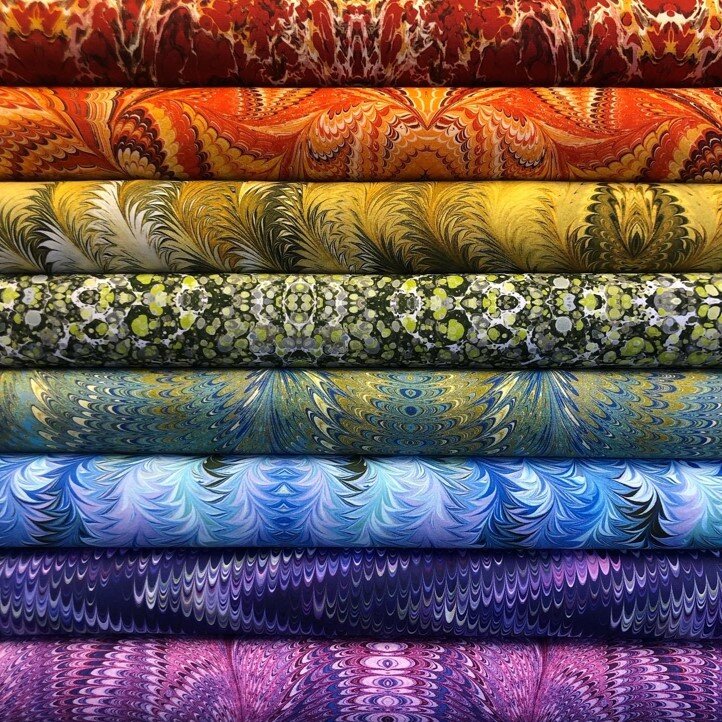Penny Patch: Assemble Blocks
This updated post is part of a series Penny Patch: a Beginner’s Quilt-Along, circa 2013. Please see this page for links to all posts.
Greetings, Penny Patchers! Choosing fabrics, cutting neat piles of squares and strips and finally sewing them into blocks - it’s all a journey of discovery since you never quite know how it will all turn out. Today we assemble the quilt top. This is the step where what we’ve imagined finally takes shape as a cohesive whole.
I love seeing the top come together!!! I hope you enjoy this part too.
Quilt Layout
So, let's review. The layout depends on what size quilt you're making. Here are the stats from the quilt design post:
BABY QUILT
Your quilt will have 7 columns and 9 rows, 63 blocks total:
31 simple squares
20 simple 4-patches
12 Penny Patch 4-patches
THROW QUILT
Your quilt will have 10 columns and 12 rows, 120 blocks total:
60 simple squares
30 simple 4-patches
30 Penny Patch 4-patches
TWIN QUILT
Your quilt will have 11 columns and 15 rows, 165 blocks total:
82 simple squares
48 simple 4-patches
35 Penny Patch 4-patches.
Step 1: Arrange Quilt
Find a big space on the floor or use a design wall (batting tacked to the wall works temporarily!) to lay out your entire quilt. Begin by arranging the simple squares (6.5” x 6.5”) in a checkerboard arrangement. The space at the very top left of the quilt should be left blank at this point. In other words, place the first simple square of row 1 in the column 2 space, as shown below. Fill out the rest of your simple square layout, according to the column/row count for your quilt type.
Next fill the blank spaces in each odd numbered row with simple 4-patch blocks and the blank spaces in each even numbered row with Penny Patch 4-patch blocks. In the photo below, I had not yet sewed my Penny Patch blocks, so they are shown unfinished, but you get the idea.
Specific fabric placement is up to you! There is no right or wrong here. There is just what looks good to you.
I tend to move blocks around a lot, playing musical blocks until things feel balanced. Watch especially that your darker colors and/or "pop" colors are evenly spread out in the quilt. And, try to avoid allowing same-colors to fall into straight line formations. Scatter, scatter! Live with it for a day or an hour (whatever is realistic). Seeing your layout with fresh eyes can really help!!!
Sponsor of the Week
Quilt Sandwich Fabrics
What’s new? This rainbow of Marble Essence prints from In The Beginning Fabrics is fresh in shop at Quilt Sandwich.
Available in yardage or by the bundle.
Step 2: Stack Rows
When you're satisfied with block placement, it's time to sew them into rows. If you need to get them off the floor, here is a method of stacking your blocks in a way that keeps track of their order.
First place a bit of masking tape on the far-right block in each row. Number the rows by writing on the masking tape.
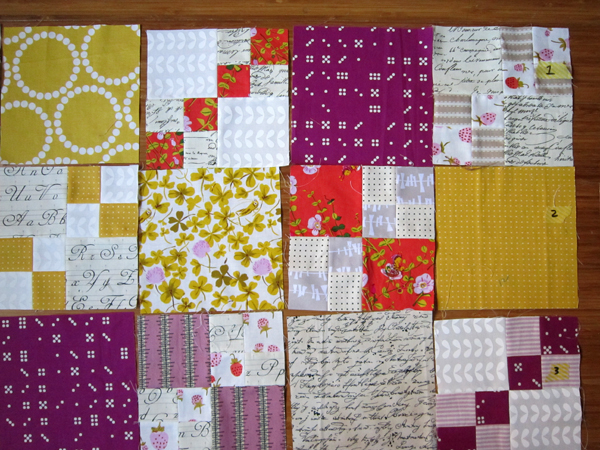
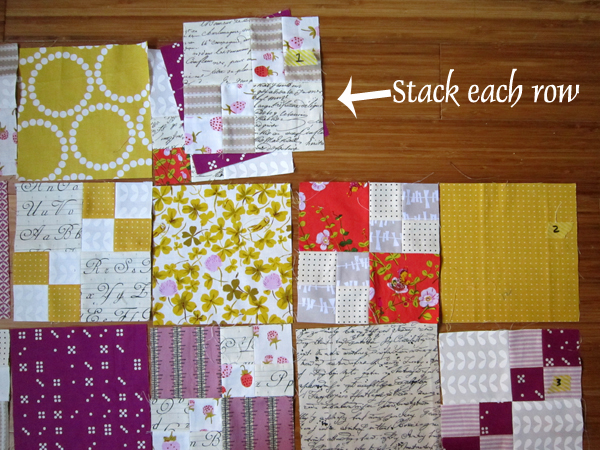
Now, working one row at a time, pick up the far-right labeled block and place it on the next block over to the left. Pick up the stack again and place it on the next block over just as before. Continue stacking up row 1, moving left and always keeping the labeled block on top. After stacking the entire row, place a pin at the right side of the stacked raw edges. This pin holds your stack together and also marks the side of the stack. Even if your masking tape label falls off, you'll have a clue as to how to lay out these blocks!
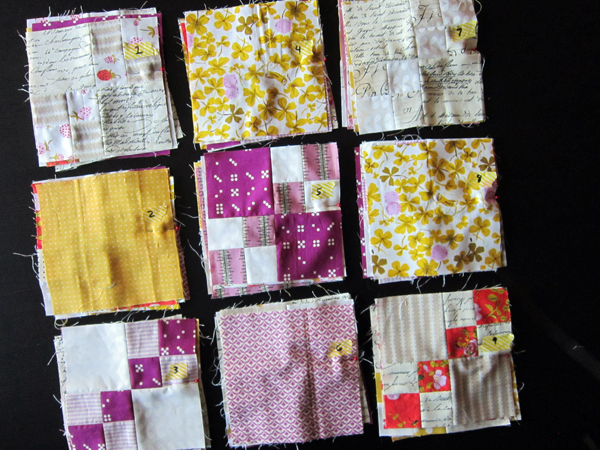
This is a good stopping point if you don't have time to assemble today.
Be sure to admire your pretty, pretty stacks!
Step 3: Chain Piece to Make Rows
Ready to sew? Ok, start with row 1 (I had already finished row 1, so I'm on row 2). Pick up the top 2 blocks. Lay them on your sewing table with block 1 (the labeled block) on the right and block 2 on the left.
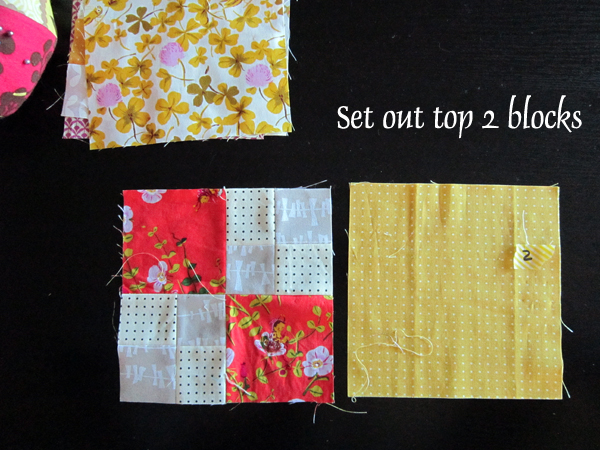
Flip block 1 on top of block 2, with right sides together. Match of the raw edge on the right - that's where you're going to sew.
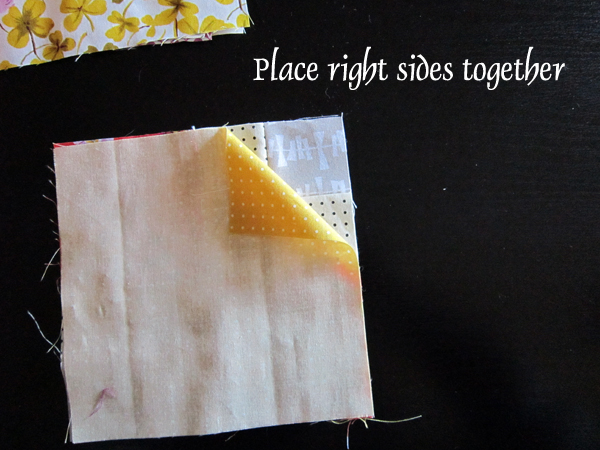
Sew blocks together with a 1/4" seam allowance. Don't cut threads after sewing. Just leave them be at the machine. Now, in the same way, pick up the next 2 blocks in your row stack. Lay them out as before with block 3 on the right and block 4 on the left.

Sew blocks 3 + 4 with a 1/4" seam allowance. Since you didn't cut threads, you can chain piece. You'll sew through "nothing" for a little bit until blocks 3 + 4 go under the presser foot. A little string of thread will connect your block pairs.
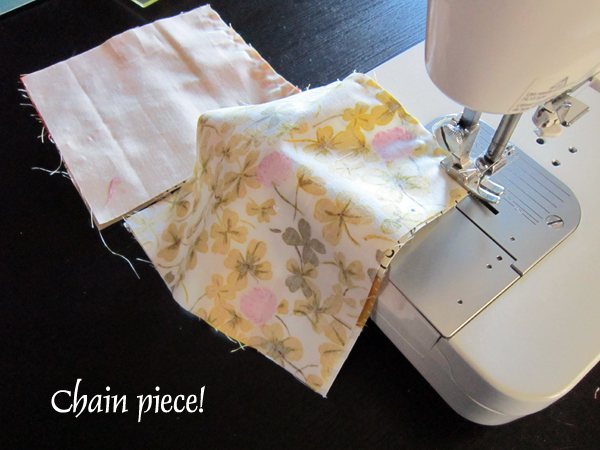
Now pick up your next 2 blocks and repeat. Keep sewing pairs until only one or zero blocks remain. Do not bother pressing any seams yet. For efficiency, press seams only after the entire row is joined.
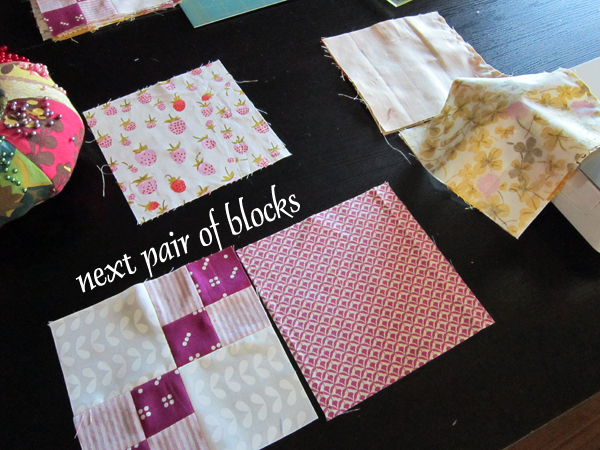
Now cut threads to separate your chained block pairs. As you do, stack the pairs in order beside your sewing machine. Continue sewing, joining all block pairs and longer sets until the row is complete.
Press all seams. Repeat to sew each row, completing one at a time.
Step 4: Join Rows as Quilt Top
If your right-most blocks are still labeled, your rows are labeled too! Let’s join them together to complete the quilt top. Remember, row 1 should begin with a simple 4-patch block. Row 2 should have Penny Patch blocks.
Arrange row 1 above row 2.
Flip row 2 on top of row 1, with right sides together. Match the seams at each 6" block and place a pin to stabilize. Then, join rows with a 1/4" seam allowance. Sew right up to the pin, removing the pin just before each block seam. If you have a walking foot, using it while joining rows can help them come together more evenly without bunching or miss-matched edges.
Join all rows as pairs, then join row pairs in the same way.
First use pins to match seams. If after matching seams, there seems to be too much fabric in places, use more pins to evenly distribute the excess fabric. That’s what we call easing in the extra fabric while maintaining matched seams for the big, 6” sections.
Rejoice! Isn’t it fun to see what you’ve created? I’d love to see it too, so don’t forget to share your pretty Penny Patch top with #PennyPatchQuilt on Instagram.



